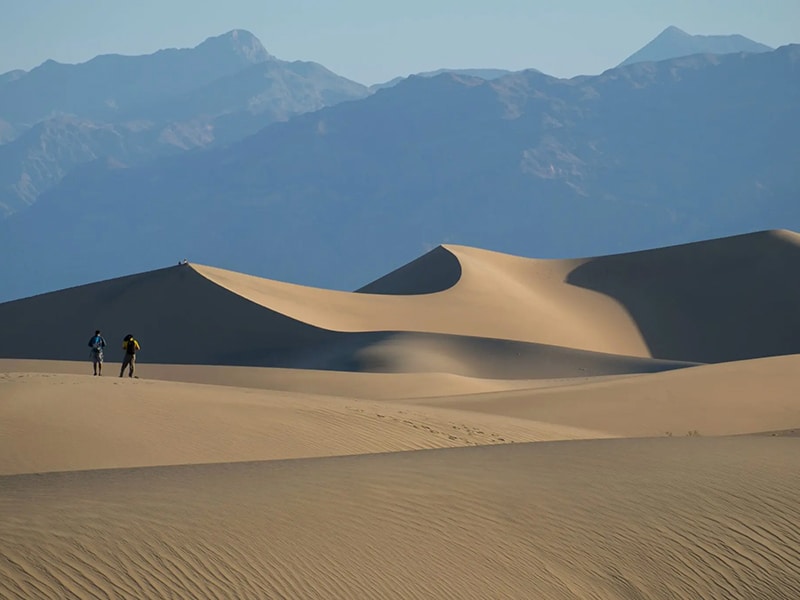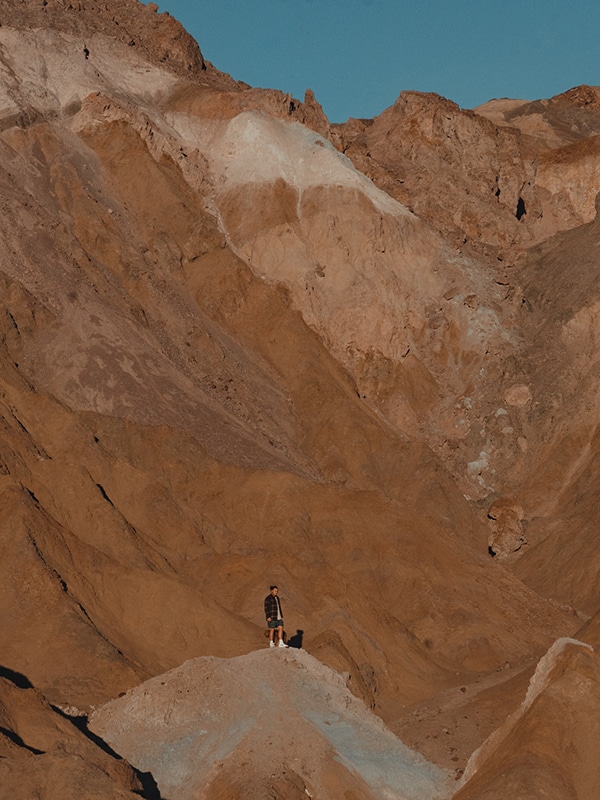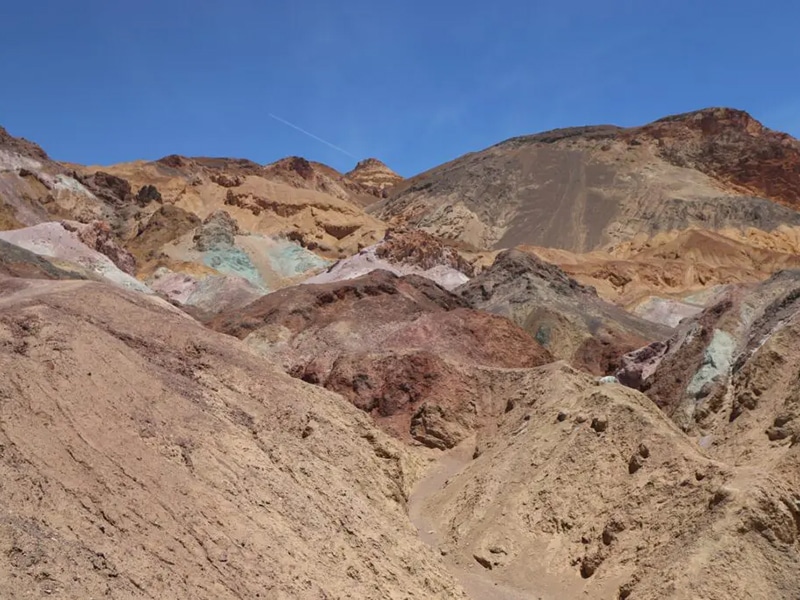
While it has a name that might make some pause before visiting, Death Valley National Park is an incredible place that is well worth the journey. Located in the Mojave Desert of California and Nevada, this park boasts stunning views, unique geological features, and plenty of outdoor activities.
If you’re looking for some helpful pointers as you make your way to Death Valley, then you’ve come to the right place. Below you’ll find a complete list of the most frequently asked questions (FAQs) and my answers accordingly. Think of this as a comprehensive guide for visiting Death Valley National Park that will set you up for success.
It’s time to take a closer look at what you can expect when you visit Death Valley National Park. Yes, it’s one of the hottest places on planet Earth, but also yes, it’s absolutely worth the visit.
Where Is Death Valley National Park?
Death Vally National Park is a desert valley located in the northern Mojave Desert that stretches nearly 5,270 miles from south-central California into Nevada. The park is managed by National Park Service and is home to countless mountains, hills, flats, and all sorts of terrain in between.
But if we’re talking about travel and adventure, Death Valley National Park is a unique and beautiful destination that offers a wide range of outdoor activities for visitors to enjoy. Whether you’re looking for a challenging hike, a scenic drive, or a relaxing camping experience, Death Valley has something to offer.
However, planning a trip to Death Valley can be a bit tricky, as the park’s extreme temperatures and remote location require careful preparation.

What Should I Pack For My Death Valley Trip?
Let’s face the facts here: Death Valley National Park is huge, with very limited amenities (or gas stations for that matter) to choose from. Therefore, it’s important to come prepared to make sure your trip is fun, safe, and memorable!
Here are a few essentials that I recommend packing:
What Are The Best Hikes In Death Valley National Park?
Since my first trip to Death Valley, I’ve been back a handful of times to take advantage of the amazing hikes and views that come with them. My favorite by far has to be Badwater Basin, Zabriskie Point, and the Mesquite Flat Sand Dunes.
With Death Valley being so big, you’re able to find a wide variety of hikes and trails to choose from, whether you want an easy and pleasant walk or a more challenging hike to soak in views of the entire park. Hiking Death Valley is possible for everyone, no matter their preference or skill level.

Zabriskie Point (Easy, 0.6 Miles Out And Back)
Shouldn’t take more than 20 minutes and offers one of the most scenic views of Manly Beacon and Red Cathedral. If you’re a photographer like me, then you’ll be in good company here with many other photography enthusiasts setting up shop to capture the perfect shot.
Mesquite Flat Sand Dunes (2 Miles+ Round Trip)
As one of the most accessible trails in Death Valley, the Mesquite Sand Dunes tends to be very busy. Go right in time for the Death Valley sunset for some amazing golden hour views. Oh, and be sure to bring a board: Sandboarding is allowed if that’s your thing.
Darwin Falls (2 Miles Round Trip)
Told you Death Valley has something for everyone. As the name suggests, Darwin Falls is a waterfall, a rather lush oasis smack dab in the middle of salt flats, tall mountains, and badlands.
Keep in mind that this hike doesn’t have a formal trail so you’ll have to do some scrambling. But the views are absolutely worth it.

Artist’s Palette (<0.5 Miles Round Trip)
While technically not much of a hike, Artist’s Palette still deserves a spot on the list of best hikes because of the once-in-a-lifetime view it has to offer. To get there, you’ll drive along Artist’s Drive, a fully paved loop. You’ll find the parking lot about 5 miles in.
This easy hike offers easily one of the most scenic viewpoints as you’re exploring Death Valley, with a wide range of colors from pinks to greens in the mountainous rocks. For Star Wars nerds, you might even recall seeing these mountains in A New Hope!
Badwater Basin (1-5 Miles Out And Back)
As one of my very first Death Valley hikes, it would be a shame to leave out Badwater Basin. On top of that, Badwater also just so happens to be the lowest point in all of North America at 282 feet below sea level.
You can’t take a trip to Death Valley and not visit Badwater Basin!
As you walk along the mostly flat trail, you’ll see the Badwater Salt Flat on either side of the trail, a nearly 200-square-mile bed of salt crystals in amazing formations. Walk in along the trail as far as you want to go while you soak in the remnants of a lake that dried up thousands of years ago.
Salt Creek Interpretive Trail (0.8 Miles Loop)
One of the best things about Salt Creek Interpretive Trail is that it is ADA-accessible, so just about everyone can enjoy this quick loop trail. Technically, this hike is more of a stroll along a boardwalk that winds along Salt Creek.
On top of offering amazing views of Death Valley’s mountains and winding hills, this trail is one of the best places to spot the rather rare Salt Creek pupfish. These fish have evolved to withstand the often 100+ degree water temperatures.
Sadly, they are currently listed as an endangered species, so seeing them in person was truly a gift.
Natural Bridge Canyon Trail (1 Mile Out And Back)
As the name implies, Natural Bridge Canyon Trail leads you to, well, a natural bridge. A quick and easy trail, the journey starts with a gravel-paved path (Natural Bridge Road) that leads into the canyon. After about half a mile, you’ll reach the opening of the natural bridge.
This, of course, is where you’ll find all the tourists setting up their self-timers and then running into the frame. Snap your pic, and then either continue down the trail toward dried-out falls or turn back around.
Where Are The Best Viewpoints To See Sunset Or Sunrise?
Because there is very little light pollution, you can enjoy an amazing view of the Death Valley sunrise or sunset from virtually anywhere in the park. However, the most popular viewpoints are Zabriskie Point, Dante’s View, and the Mesquite Sand Dunes.
If you ask me, Zabriskie Point is my personal favorite because it’s a quick and easy walk up to the viewpoint.
This article was originally published on Wayfare with Piere. To read the full guide visit WayfareWithPierre.com
